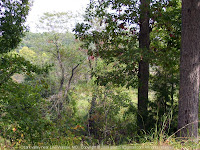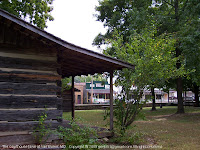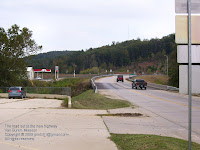An interesting Ozark village
I dawdled a little on my way home from Kansas, a few weeks ago. My ten-minute stop at a gas station along the highway turned into a two-hour visit to downtown Van Buren, Missouri.
Let me explain. I've been traveling through southern Missouri for 19 years now, on my way to and from family gatherings. Highway 60 was (and is) the most direct route from Cairo, Illinois, to Springfield, Missouri. When I started driving Highway 60, it had some very narrow, crooked passages through the ridges and valleys of the Ozarks.
Highway 60 to Van Buren
The very worst part of the road was the 25 miles just before Van Buren, Missouri, and the 25 miles just on the other side of Van Buren. Woe to the trucks that were forced to travel that twisting snake of a road. Woe to the cars that were trapped behind the trucks. Woe to the children trapped in the back seats -- especially those who suffered from car-sickness -- and woe to their parents.
Because I remember the old road vividly, I appreciate the new 4-lane road that leads into Van Buren from the east. The road through the most mountainous area west of Van Buren is now 3-lane, and it will soon be 4-lane, too. The taxpayers of Missouri (and I suppose, the entire nation, through Federal highway grants) should be proud of this highway. I'm sure it's been an engineering challenge to build it.
 Until the roads were blacktopped and tourists began driving through the Ozarks, most people around Van Buren made a living, one way or another, from the Ozark hills and trees. Country folks grew and made most of what they needed. Van Buren's handful of stores supplied the rest of what people had to have. A trip to Poplar Bluff or Springfield would have been a rare adventure in a big city.
Until the roads were blacktopped and tourists began driving through the Ozarks, most people around Van Buren made a living, one way or another, from the Ozark hills and trees. Country folks grew and made most of what they needed. Van Buren's handful of stores supplied the rest of what people had to have. A trip to Poplar Bluff or Springfield would have been a rare adventure in a big city.I saw, sensed, and imagined things like this, during my many trips on the treacherous old road to Van Buren. The big new road doesn't inspire nearly as many thoughts of this sort.
A river town
The Current River runs briskly along the west edge of Van Buren, and you can walk right up to the water on either shore. Small watercraft -- flatboats, canoes, and rafts --were once important modes of transportation through the area. The river crossing at Van Buren was valuable property during the Civil War. Several skirmishes occurred in this area between Union and Confederate/guerilla forces. Today, the river is popular again for rafting and canoeing.
Tree covered ridges dominate the skyline at Van Buren. If there are any grain elevators or smokestacks in the little town, I've never noticed them.
The Carter County courthouse, a WPA project and Missouri's only cobblestone courthouse, sits in the center of a well-shaded town square. It is the tallest building in downtown Van Buren and probably the entire town.
The historic marker on the courthouse lawn tells how Carter County's primeval forests were clear-cut around 1900, bringing two decades of boom to the area before the last trees were cut and the sawmills closed. I think that Van Buren is still struggling to overcome that setback. Tourism has helped.
 The commercial buildings around the square are modest structures, and the houses along the highway are modest, too. It appears to me that Van Buren has never enjoyed much excess of wealth.
The commercial buildings around the square are modest structures, and the houses along the highway are modest, too. It appears to me that Van Buren has never enjoyed much excess of wealth.Visits to Van Buren
I've stopped in Van Buren many times and wandered around for a few minutes. My kids will read this and remember photographs of themselves in Van Buren. Sometimes we stopped and walked around the courthouse square, when we were traveling to or from Aunt Charlotte's house.
When I passed through Van Buren most recently, I stopped at the new station along the big new highway for gas and a brief stretch. I intended to get back in the driver's seat and hurry down the road, but nostalgia called me. I decided to drive down to the river and find an interesting rock to take home. It would only take a few minutes, I told myself.
 Near the river, on the street that used to be the highway through town, I saw a little sign that said "Hidden Log House Museum". After I had found my rock at the riverside, I decided to see what the museum looked like from the outside. Then I got out of my car to take its picture, and while I was doing that, the lady who owns the museum came outside to talk to me.
Near the river, on the street that used to be the highway through town, I saw a little sign that said "Hidden Log House Museum". After I had found my rock at the riverside, I decided to see what the museum looked like from the outside. Then I got out of my car to take its picture, and while I was doing that, the lady who owns the museum came outside to talk to me.I had to go inside. It would have been rude to drive away, and the admission was only $2. Besides, I was curious. It turned out that the little museum was well worth the visit. I've never been disappointed by a stop in Van Buren.



8 comments:
This is what the people who live on the coasts mean when they talk about fly-over country. There are many thousands, even millions of people living their lives and minding their own business and they don't really give a hoot about what's going on in LA or NYC. And neither do I.
Exactly, Mark.
Genevieve: What was 'hidden' about the log house? Was it one of those log houses covered with more modern siding?
Well, I prefer to think of it as the heartland of America, not flyover country, but you know me. I love this part of the country.
The museum house is indeed a log house covered over. In fact, its log room was built right after the Civil War, as the new courthouse. The old courthouse (and the entire village, whatever there was of it) was burned during some of the fighting over the river crossing. The river was important because it was a quick, easy route into northern Arkansas.
Sometime over the weekend, I'm going to post some photos of the Hidden Log House Museum's exhibits.
Very interesting that the cobblestone courthouse was a WPA project. Edmond, OK has, or maybe had, a cobblestone community center when we lived there in the late 1980s. Maybe it was a WPA project, too.
http://www.edmondhistory.org/museum-information/ The Edmond building was the old armory constructed by the WPS, which I had forgotten. Now it is the historical society museum.
I lived in Carter County for about 10 years...10 miles west of Van Buren in Fremont.I have been away for 27 years and all I can say is ...it sure is pretty, but I wouldn't want to live there!
I've always wanted to visit the Ozarks, but I've made no plans. Since a lot of Chicago people retire there, I figure some sort of reason will bring me there.
One day.
Genevieve,
Great post -- so many off the beaten path towns. When I know there is a neat little spot of settlement I'm off the road headed in that direction -- like you did in your post. Always something to learn about our country, region or the place we call home. -- BARBARA
P.S. I pick up rocks too.
Post a Comment